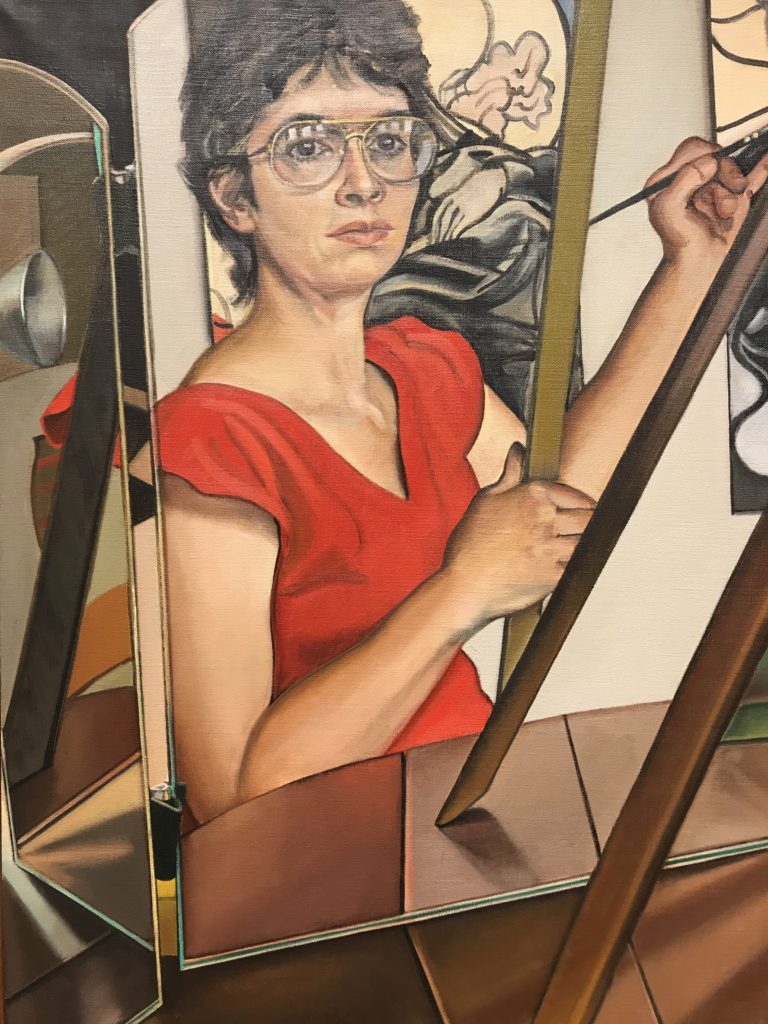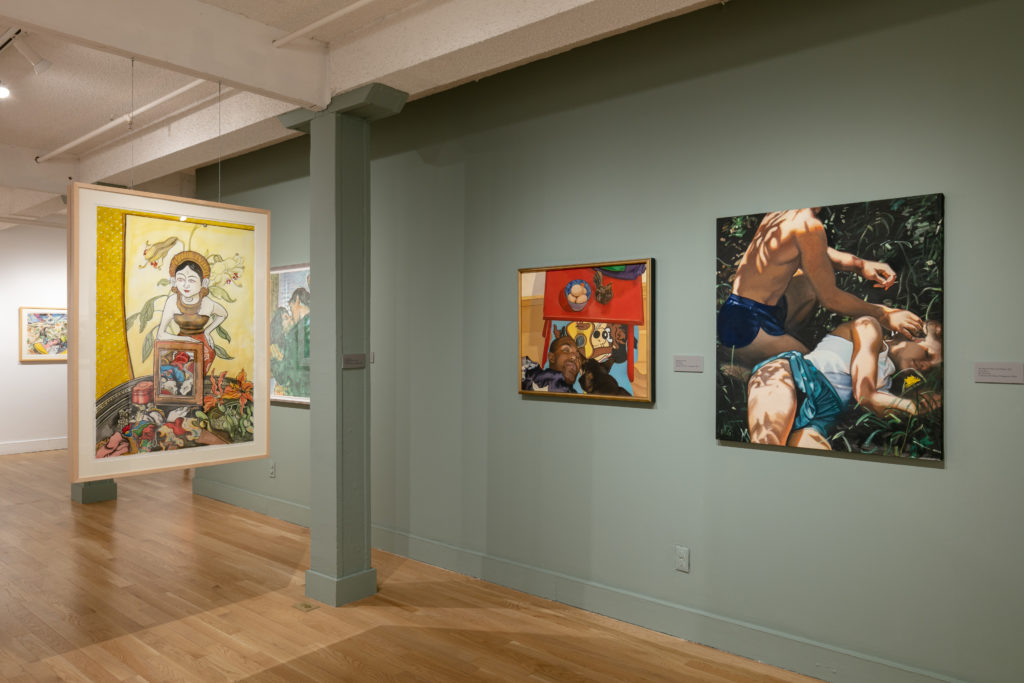
Walking into Margaretta Gilboy’s retrospective, Flying in the Hands of Time, at the Boulder Museum of Contemporary Art (BMoCA), it’s easy to pretend — despite the biting cold and dirty piles of plowed snow outside — that it’s spring. Inside, there are flowers everywhere, fruit, babies, birds, young lovers in skimpy clothes sharing a kiss in dappled sunshine.
Gilboy, who passed in 2017, was a longtime practitioner and teacher of Qigong (pronounced chee-guhng), a centuries-old practice combining posture, movement, breathing and meditation to promote healing, both spiritually and physically. In traditional Chinese medicine, qi is energy, the force that drives living things, and Qigong is the practice of cultivating and balancing this energy. For more than a decade, Gilboy studied Qigong with FaXiang Hou, a fifth generation Chinese Qigong master.
Gilboy, who was born in Philadelphia but spent much of her adult life in Colorado, taught a therapeutic class in Boulder for many years called Spring in Winter Qigong.

“[Spring] is a heady, invigorating, sometimes disturbing season with wild fluctuations of energy surging throughout nature as birth, arousal and movement,” writes practitioner Ron Davis for the Shambala Mountain Center. “The momentum created by spring qi gives structure and impetus to the world: young trees thrusting skyward, icy rivers flooding valleys, babies everywhere screeching with the joy of life. In humans, Qi rises like a slow tide coming up from its winter storage in the lower abdomen and moving into the chest where it stimulates the liver with fresh vitality.”
This is the energy Gilboy cultivated in her artwork: a constant sense of rebirth, optimism in the face of life’s difficulties, new perspectives on the mundane. Her work holds all the hallmarks of still life — fruit, bowls, flowers, trinkets of all shapes and sizes — but it skews far from the traditional work of the Dutch masters who popularized the form in the 16th century. Gilboy’s love of Asian art, particularly Japanese woodblock prints, mingled with her proclivity to blend the real and the surreal, the significant and the common place. The influences found in Gilboy’s work are varied, if sometimes inconspicuous.
“Maggie loved cubism,” says Gilboy’s friend Simon Zalkind, who curated the BMoCA retrospective. “She loved something about the postmodern aesthetic, which gives free rein to the pairing or the coupling of objects that are dissonant or from different periods, different times. She was actually very, very contemporary within a context that mined the possibilities of traditional genres. I think of her as a very contemporary artist.”

Zalkind met Margaretta Gilboy (Maggie to her friends) sometime in the mid-’80s after he moved to Colorado from New York. A curator for several museums in New York and Colorado, as well as an independent curator and art advisor for private collections, Zalkind found Gilboy rather naturally through his work when Standard Oil (which at the time had an office on 17th Street in Denver) requested Zalkind acquire one of Gilboy’s paintings for its office.
“I remember looking at one [of her paintings] and having one of those profoundly disorienting experiences of beauty,” he writes in the introduction to the book he helped produce about Gilboy’s retrospective. “They were tenderly and expertly painted and brimming with a seemingly incongruous and occasionally off-kilter deployment of objects and art-historical references, both Western and Eastern. In them, the most quotidian of domestic tchotchkes could find itself in an oblique dialog with a canonical, art-historical masterpiece.”
In Gilboy’s piece “Gone, Gone” (oil on canvas, 2009), a vase of mixed flowers — pink begonias and yellow Mai flowers — sits atop a table, a mirror just in front of the vase. In the mirror’s reflection is Vermeer’s “Girl With a Pearl Earring.” Here Gilboy nods to new beginnings (as well as Asian culture) with the yellow Mai flowers, which are traditionally associated with celebrations of Tet, the Vietnamese Lunar New Year. The mirrored image of the Vermeer opens the painting up both spatially — giving the viewer a sense of the world outside the painting’s frame — and metaphorically — allowing the viewer to wonder how Vermeer’s masterpiece relates to the work.
Mirrors abound in Gilboy’s art, often fracturing the perspective in a way that can be disorienting and exciting.
“I think the use of mirrors in some ways also implies the reflection of the person looking [at the painting],” Zalkind says. “I think that was one way that people are sort of drawn in, but I do think she was interested in reflective surfaces and in the way that they can fracture a picture, but even the images that are kind of fractured, so to speak, I think will leave you with a sense of their wholeness.”
“I orchestrate objects on the table in a composition until the arrangement clicks inside of me,” Gilboy said in an artist’s statement from 2010. “My paintings explore the experience of being human. Connection, love, impermanence, loss, joy and mystery within the context of art and artifacts are my subject matter.”
Gilboy’s home, Zalkind says, also reflected this sense of “unconscious curation of objects.”
“I was always envious because everything looked like it had found the place it should be without any contrivance,” he says. “In a way, her home was a lot like her paintings — there were a lot of unlovely things that she made lovely simply by valuing them.”
Everything in Gilboy’s art seems of the moment, timeless even. Her portraiture comes alive on the canvas, often taking on a blurred aesthetic like that created by a camera’s narrow aperture in low light. She presents humans — and often dolls — as “earthbound,” Zalkind says, “not as ciphers for some hidden transcendental abstraction.”
A Chinese acrobat — clad in cherry blossom pink, surrounded by orchids in bloom, her smile as beguiling as the Mona Lisa’s — greets you as you step into the retrospective. Her smile says it all: Here in this make-believe spring you are allowed to feel hopeful, joyous, connected… reborn.
“I wouldn’t call her uplifting in any simplistic kind of uplift way,” Zalkind says. “She was just a person with tremendous libido, by which I mean she had a lot of life force and it radiated and suffused the experience of everyone she encountered.”
ON THE BILL: Margaretta Gilboy: ‘Flying in the Hands of Time: A Retrospective.’ Boulder Museum of Contemporary Art, 1750 13th St., Boulder. Through May 25.














